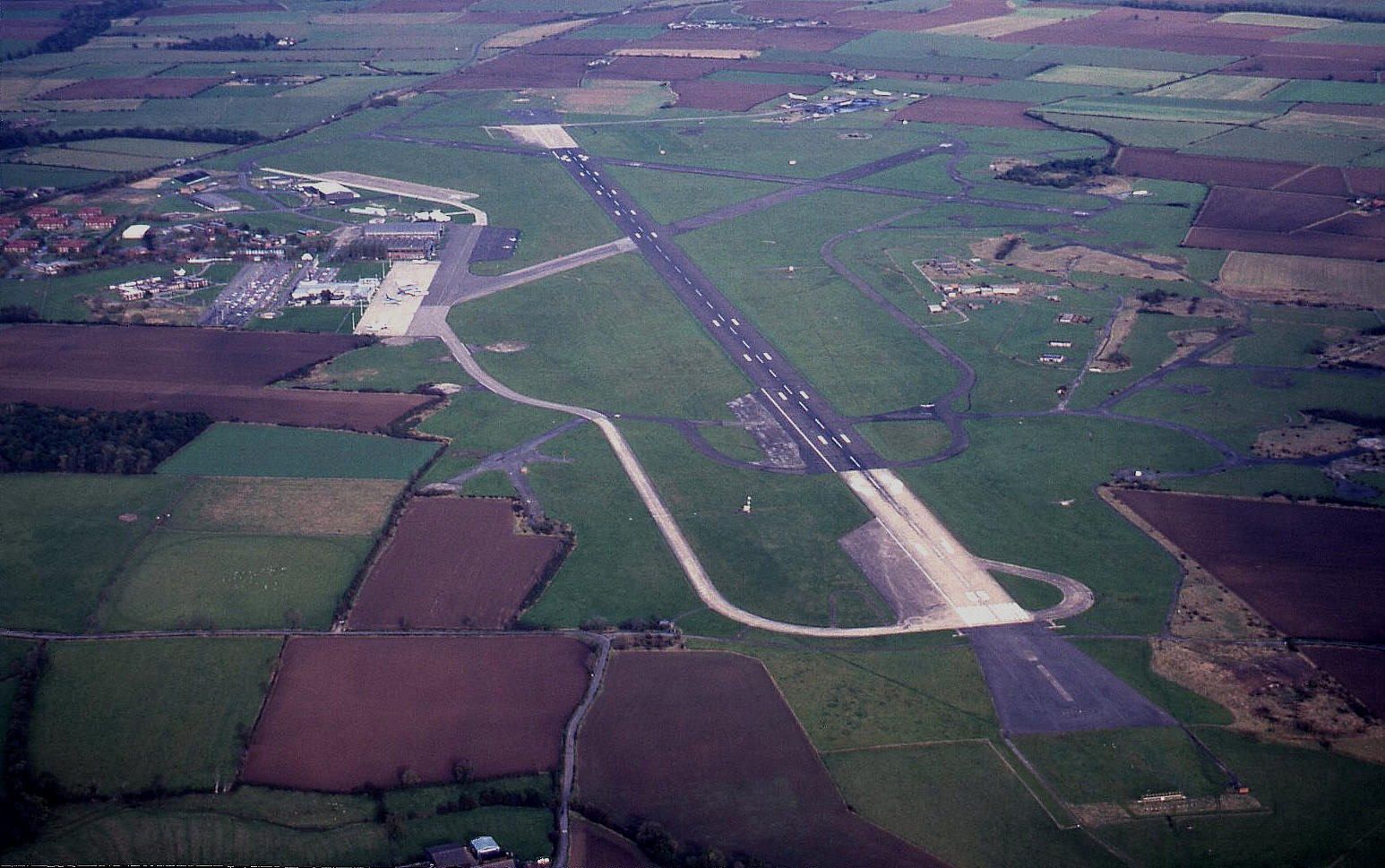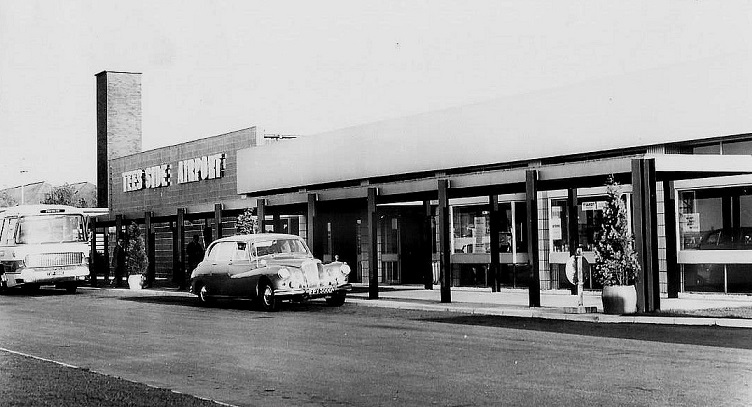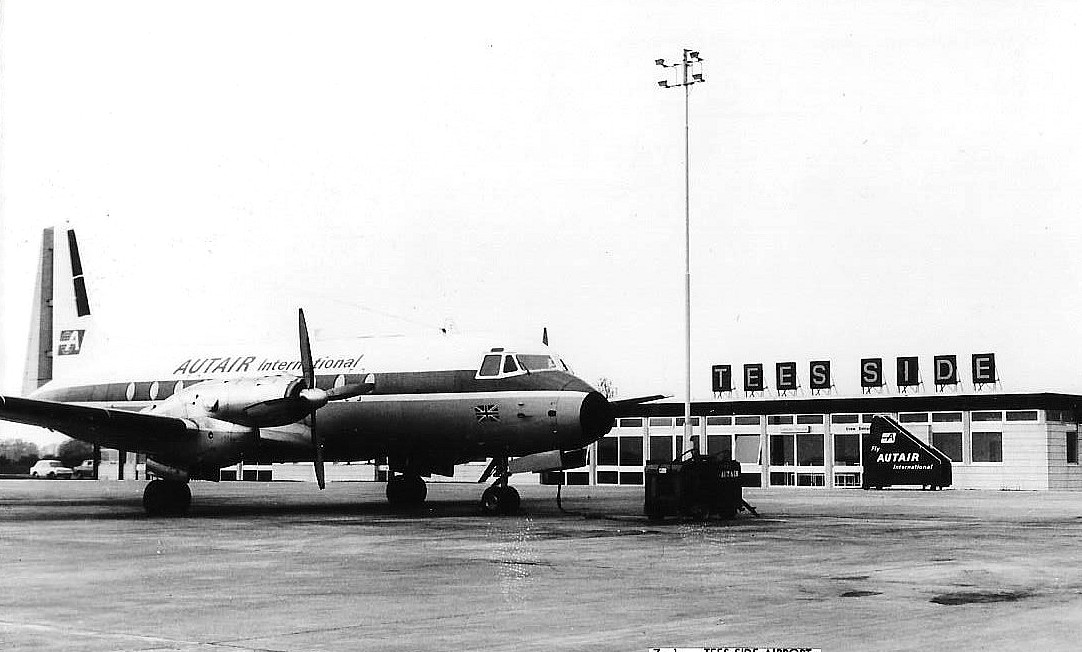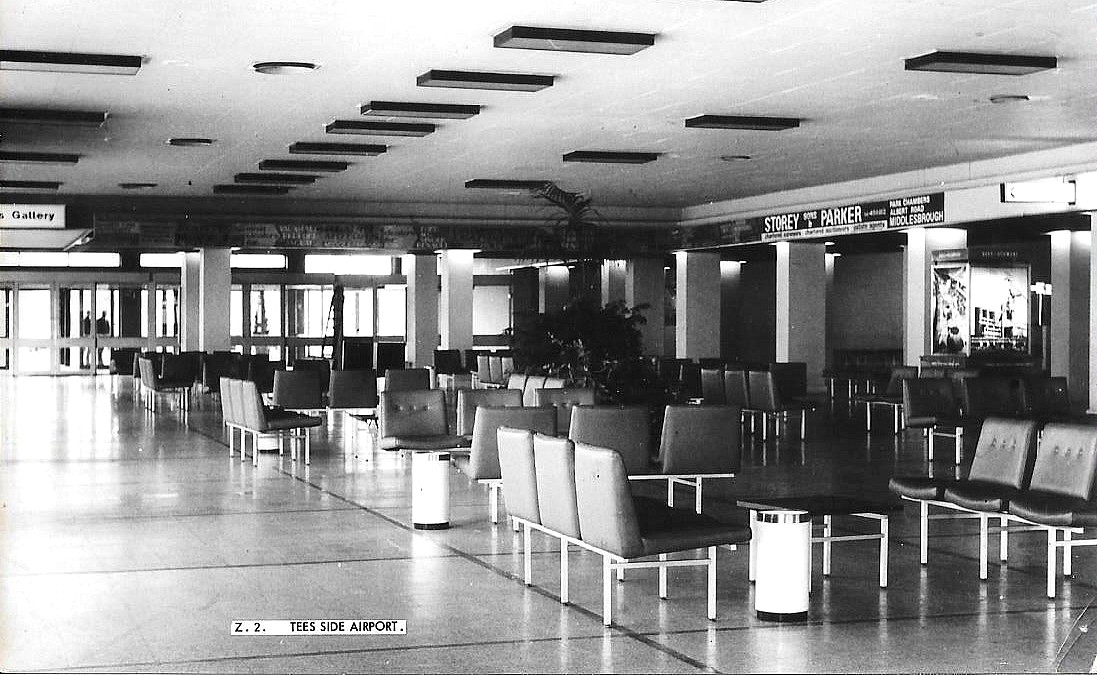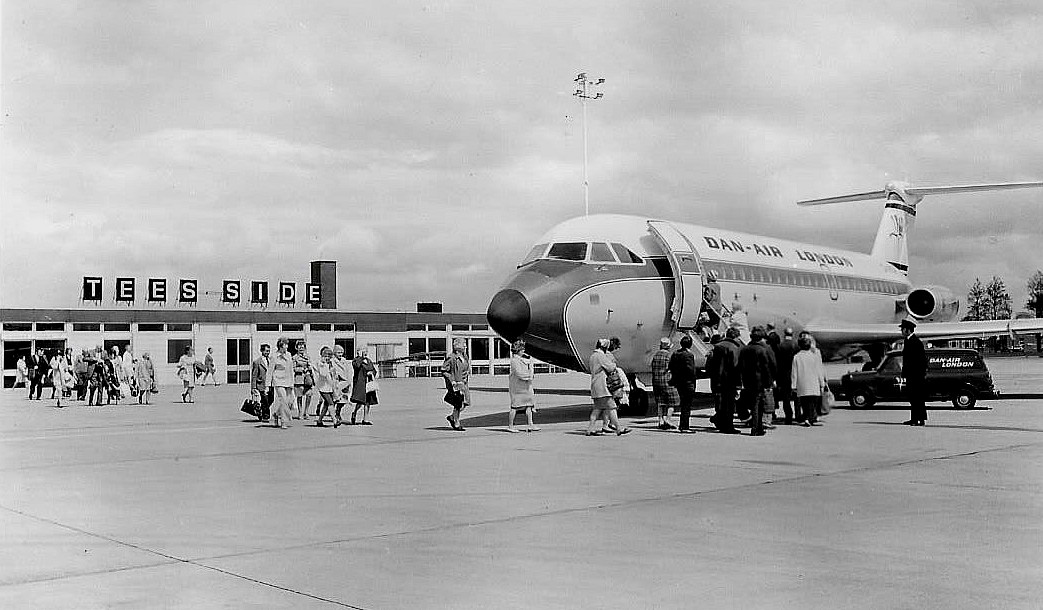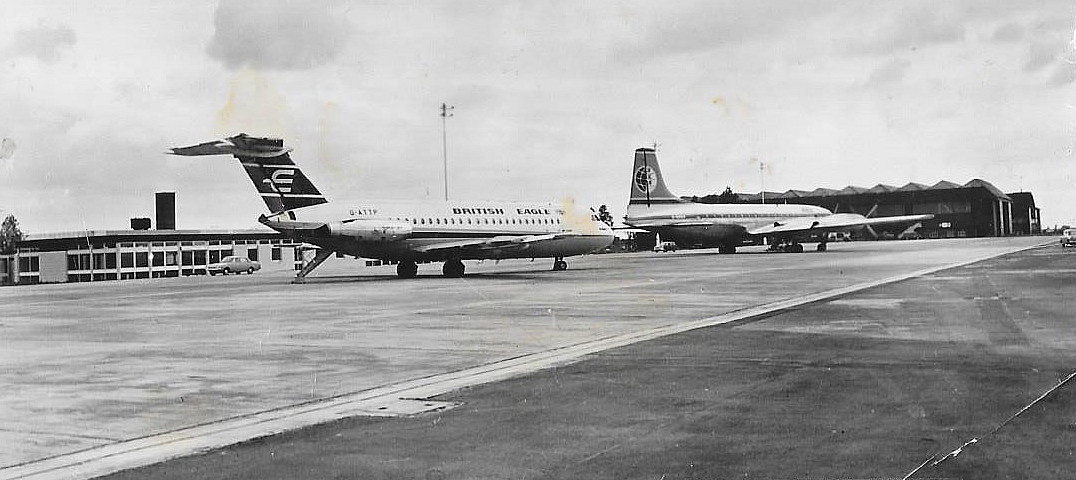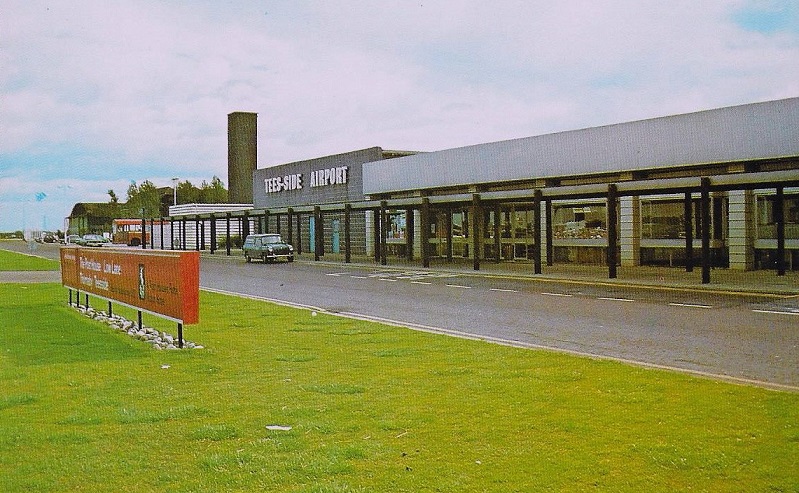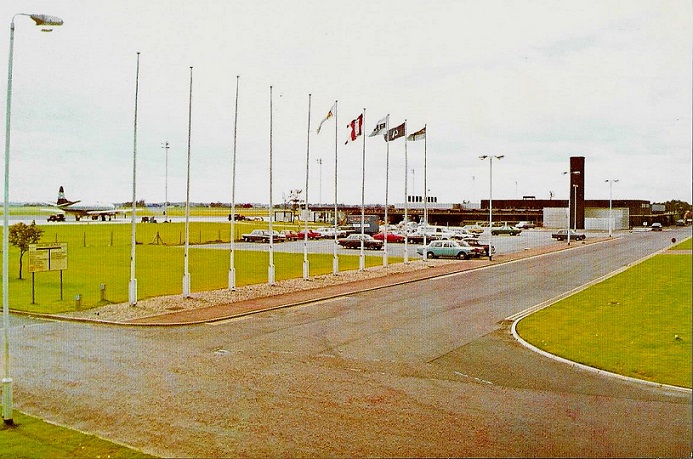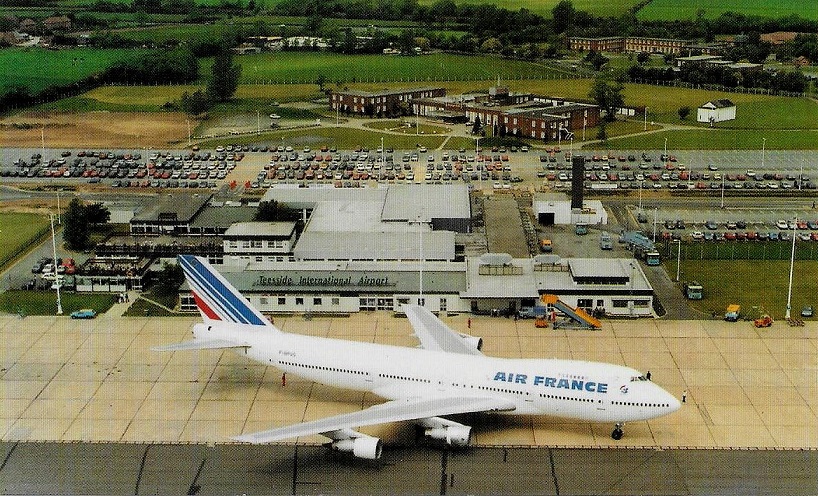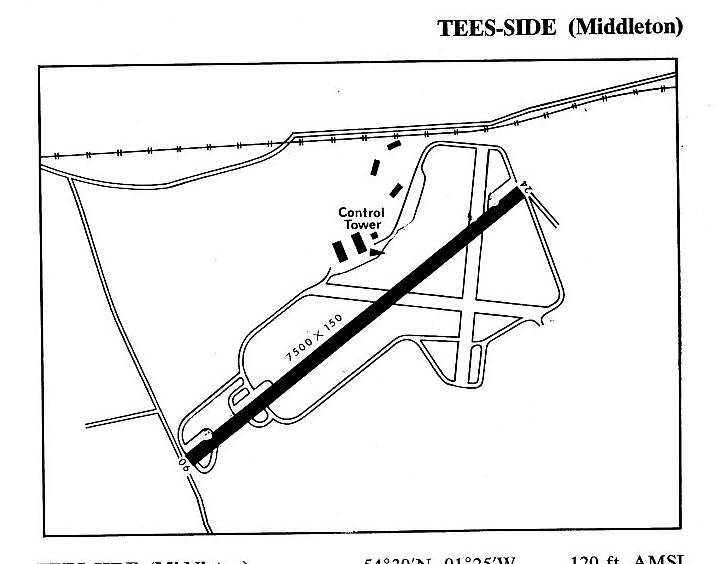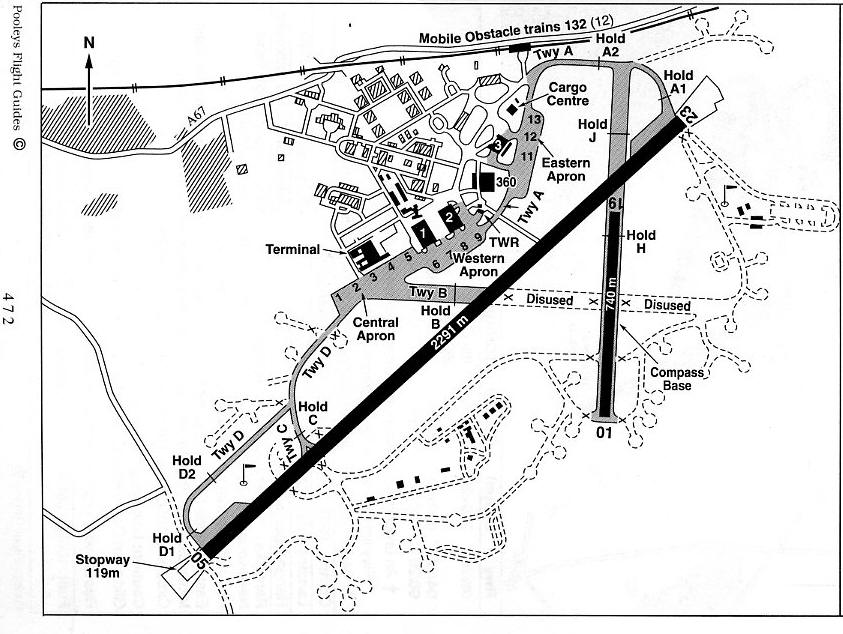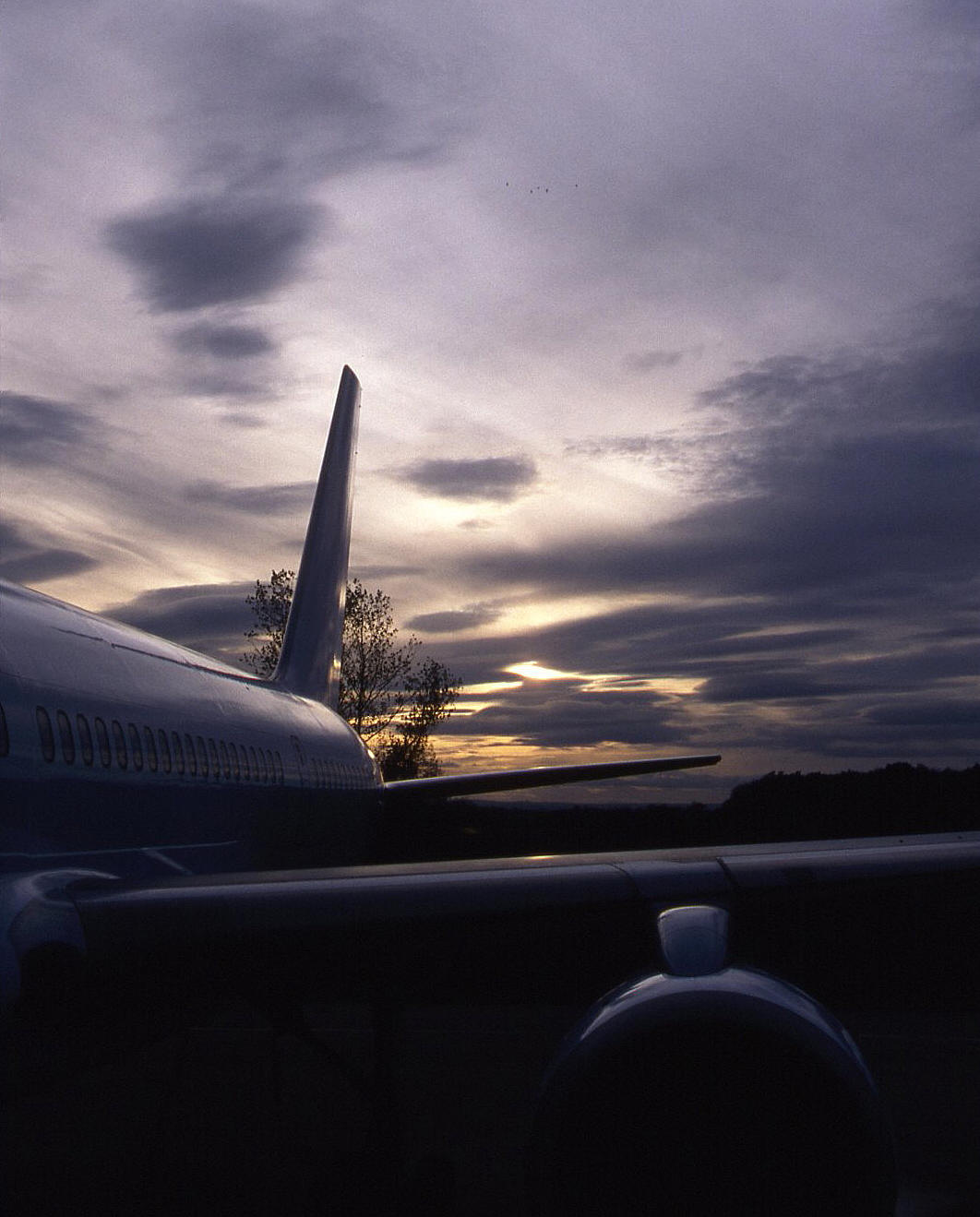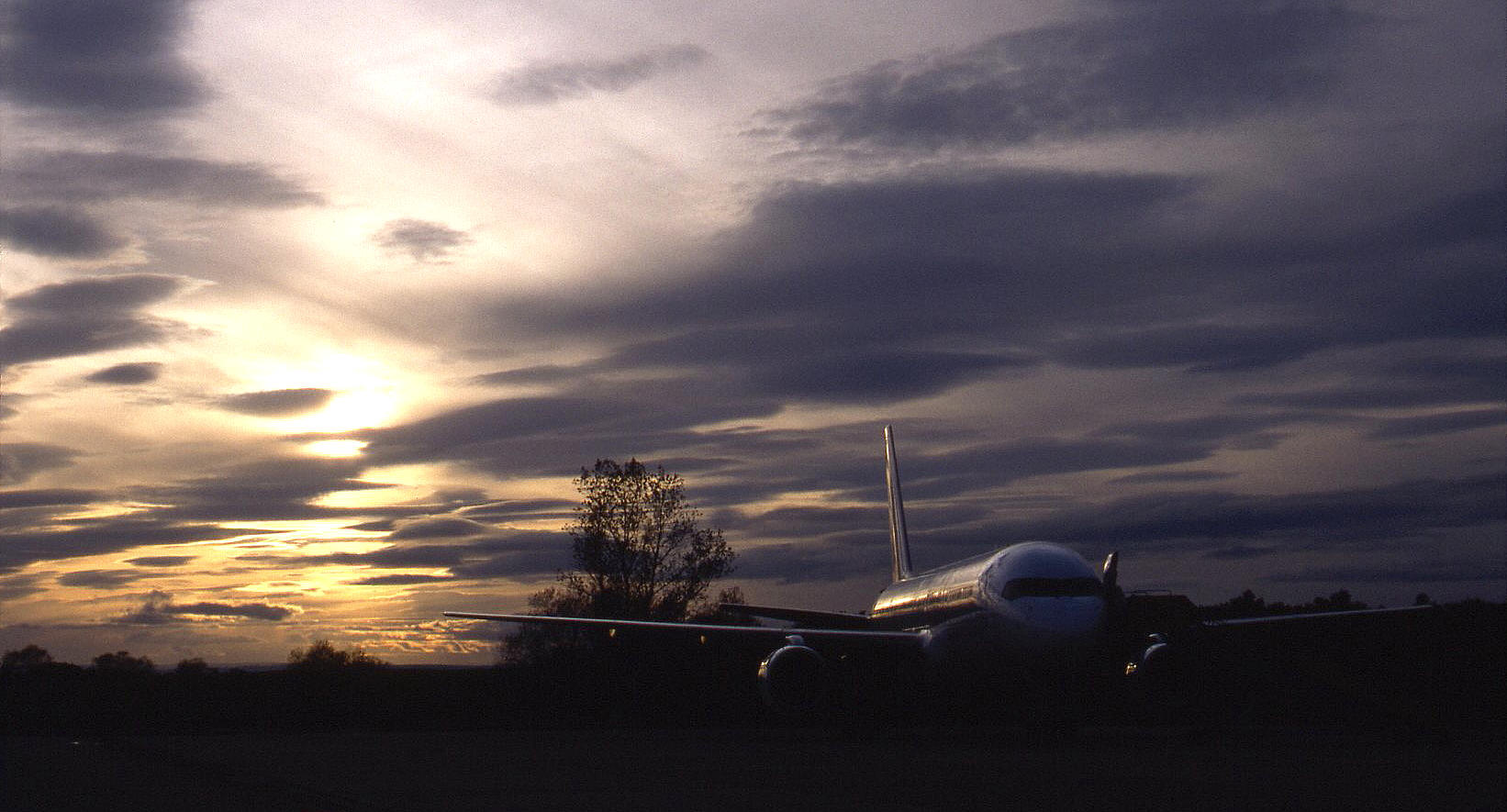Teesside Airport
TEESSIDE: Military aerodrome WW2 MIDDLETON St GEORGE Later civil regional airport
Note: Pictures by the author unless specified.
ICAO code: EGNV IATA code: MME
Picture by Austin J Brown:
Military users: WW2: RAF Bomber Command 6 Group
76 Sqdn (Handley Page Halifaxs)
78 Sqdn (Armstrong-Whitworth Whitleys)
419 & 428 (RCAF) Sqdns (Vickers Wellingtons then Halifaxs and later Avro Lancasters)
Post WW2: RAF Fighter Command
'V' Bomber dispersal airfield
33 Sqdn (Gloster Javelins)
226 OCU (English Electric Lightnings)
Operated by:
1965: Teesside Airport Joint Commitee
1975: Department of Trade & Industry
1990/2000: Teeside Internatonal Airport Ltd
A MIKE CHARLTON GALLERY
Note: These pictures from postcards were kindly sent by Mike Charlton who has an amazing collection: See: www.aviationpostcard.co.uk
Fifth picture. The British Eagle BAC One-Eleven 207AJ, G-ATTP in the foreground, was previously VP-YXA, destined originally for Central African Airways. It appears this African airline screwed the deal up and this aircraft was registered to British Eagle International Airlines from the 28th of April 1966 until the 14th December 1967 - when it went to Zambia as 9J-RCH.
Restored to the UK register on the 26th March 1975 it seems it served with Dan Air until November 1991 when it went to Chile.
Eighth picture: I think this picture could well have been taken on the first visit to TEESSIDE by the Air France Boeing 747-128 F-BPVD on the 6th June 1970? Probably a charter flight to Lourdes/Tarbes in France? It appears that F-BPVD made three more visits, the last being in 1993. It also appears that three other visits by civil 747s have been made.
However, and without any doubt whatsover, the singular visit by the Boeing 747 'Air Force One' on the 21st November 2003 has to be the highpoint of 747 visits to this airport. This was at the end of a State visit when the then British Prime Minister Tony Blair was utterly in awe of the US President George W Bush, and bent to his every whim - including utterly futile wars in Iraq and Afghanistan. Which, as we now know, (as if the result wasn't totally predicted), has rendered these regions devastated, and probably to remain so for a long time to come,
British airline users: Air 2000, Air Anglia, Airtours International, Air Kilroe, Autair, BKS Aerocharter, Britannia Airways, British Midland Airways, Northeast, Thomson fly
Foreign airline users: Air Europa, Intersun, Ryanair, Wizz Air
Charter/air taxi: Air Services (Sunderland), Beacon Air Services, BKS Aerocharter, Casair Aviation Services, Channel Airways
Flying club/schools: Post 1945: Beacon Air Services, Cleveland Flying School, Middleton-St George Aero Club, St George Flight Training Centre, Teeside Aero Club, Teesside Flight Centre
Note: From the 18th of February 1966 until the 1st July 1967, the Middleton St George Aero Club were operating the Auster J/5B Autocar G-AMFP. Other aircraft too perhaps? A picture of this aircraft can be seen flying in the SOUTHEND listing.
Pleasure flights: Post 1945: Beacon Air Services
Other users: Post 1945: FR Aviation
Location: S of the B1373, (now the A67?), about 5nm E to ESE of Darlington town centre
Period of operation: 1941 (military) Civil from (?) to present day
Runways: WW2: 01/19 1280x46 hard 05/23 1829x46 hard
10/28 1280x46 hard
Note: These maps are reproduced with the kind permission of Pooleys Flight Equipment Ltd. Copyright Robert Pooley 2014.
1965: 06/24 2286x46 hard
1990/2000: 01/19 740x18 hard 05/23 2291x46 hard
NOTES: There can now be no doubt that RAF squadrons manned by crews from the Dominions, or as we now know them - Commonwealth countries, (who formed a large contingent in Bomber Command), were very badly treated, at least up till mid 1943. Invariably they were given the worst aircraft of least performance and consequently faced the greatest danger and subsequent losses. It really is a disgraceful episode in our history, and just one of many of course.
I can highly recommend reading Bomber Boys and Men of Air by Kevin Wilson who has quite probably done more to both explain and help celebrate the memory of the quite appalling sacrifices so many crews of Bomber Command made. Those hugely irresponsible and obviously ignorant people, (who we find today, both in the UK, Germany and elsewhere), claiming that the bombing campaign was unjustified are a disgrace, and almost without any doubt now owe their right to make such outlandish statements, (I shall resist saying in a ‘free’ democracy because these do not exist), largely because the bombing campaign was the only means the Allied forces had to try and defeat the Nazi regime until well after the D-Day landings.
ANOTHER COMPELLING ACCOUNT
Another author who provides a compelling account and much insight into the RAF bombing campaign is John Sweetman in his excellent book Bomber Crew. I think the following passages are well worth recounting here: “On 20/21 February 1945, Sergeant Stan Instone flew to Dortmund as the flight engineer of a 419 Squadron Lancaster from RAF Middleton St George, County Durham, in a force of 528 aircraft. Approaching the target, he saw upward-firing cannon of a night fighter (the deadly schräge Musik) account for a Lancaster ahead and shortly afterwards his own aircraft suffered the same fate.
The starboard middle tank burst into flames and, as the fire could not be controlled, the pilot gave the order to bale out. The navigator went forward to leave by the front hatch with the bomb aimer, but that jammed. The rear gunner called up to say his turret was frozen and Instone went back to help him. As he did so, he saw that the mid-upper gunner and wireless operator had already left via the rear door.” Later; “In a prison camp he would meet up with four other members of the crew. Flames engulfing the fuselage had unfrozen the turret, whose occupant had escaped minus one trapped boot. Later they learnt that the navigator and pilot had not survived.”
My note: This was entirely typical of a situation many hundreds of bomber aircrews faced.
“Amid the pandemonium, the pilot held the aircraft steady. After desperate hammering the bomb aimer and navigator got their hatch open, but Instone could not free the rear gunner. Making his way forward again, he sat on the edge of the open hatch and remembered nothing more "until I came to free falling with pieces of the aircraft dropping past me". Instone just had time to pull the ripcord before he crashed through a copse of pine trees on to the ground; except for temporary deafness, he was unscathed. Having lost his escape kit in the swift descent, Instone had no sense of direction and was quickly rounded up.”
My note: Even with an escape kit few aircrew who had baled out stood had little chance of escape when landing in Germany. As often as not their descending parachute had been spotted even at night. It must be remembered that the sheer volume of noise created as the bomber stream passed overhead pretty much made sleep impossible, and this obviously included those in rural districts. And, there was always the chance of a ‘jittery’ aircrew releasing their bombs well away from the target, as very often happened. It is a myth that all RAF bomber crews steadfastly resolved to bomb the target.
ANOTHER TRUTH?
Those from the Empire or Dominions came to this island absolutely imbued with a great sense of duty and purpose to help win this war. It wasn’t so simplistic for many of those who lived here. Many would have, to some degree, doubts about their purpose in even fighting this war - memories of WW1 still resonated. A great many British people were dead against it, and even those who considered themselves patriotic people, (possibly especially so in rural areas?), often wrote letters of complaint to the press about the noise nuisance and the Trade Unions organised strikes in urban areas. There are accounts of the Church of England senior members providing considerable resistence to having an airfield built, (or even if a nearby church spire needing to be removed), whilst quite hypocritically endorsing their clergy to bless aircrews embarking on raids involving mass murder!
THE 'SKIPPER'
In a RAF bomber crew during WW2 the pilot, the ‘skipper’; to some quite large extent, assumed a role exactly mirroring the image of a naval captain, who goes down with his ship, it being a matter of honour. Today it is perhaps hard to understand exactly how strong these concepts were but there are many accounts which clearly illustrate that the bonds formed by aircrew superseded everything, even family bonds. To illustrate this John Sweetman records. “Many years afterwards, Instone penned a moving tribute: ‘Few words can express my feelings towards our skipper, Flying Officer L. A. Blaney RCAF. With his quiet authority and friendliness he commanded a crew with a tremendously strong bond of comradeship and, as Captain, he gave away his own chance of survival so that his crew should have theirs’.”
WHAT WAS GOING ON?
Hindsight is of course a luxury afforded to the following generations but surely there can now be no doubt about the often utter incompetence, sometimes stupidity and almost total lack of professional capabilities across the board within the higher echelon officers in RAF Bomber Command, certainly in the early years. Their decisions meant that thousands of aircrew lives were simply thrown away without producing any noteworthy effect on the Nazi regime. But of course WW1 had only ended just over twenty years before so is it fair to assume many of the attitudes prevelant amongst the military chiefs in that war were carried over into this conflict?
SOMETHING TO THINK ABOUT?
Let us remember that ‘Butcher’ Harris, (as he was known by his aircrews in WW2), not ‘Bomber’ Harris as he is popularly known today, was a WW1 pilot. So it is really so surprising that his principal approach to bombing Germany closely resembles a charge from the trenches?
If the first raid fails chuck more lives at it! It was a numbers game basically, as he’d explained to Churchill. And who knows, he may well have been proved right that bombing alone could win the war if the sufficient numbers of bombers and crews he asked for were provided? As has been proved since, time and time again, bombing does not win a war - only 'boots on the ground' achieve this.
ANOTHER POINT
Also don’t forget, ‘Butcher’ Harris was much against the ‘Dam Busters’ raid but he was over-ruled. To his credit he admitted his mistake just after the raid took place but concepts like flexibility, ingenuity, inventiveness etc didn’t really ever enter into his approach. There is another aspect regarding this famous raid which appears is now emerging - and that is that the senior RAF staff involved in planning the 'Dams Raid' deliberately ignored the advice of Barnes Wallis - therefore deciding to minimise the overall damage inflicted. Although this might sound incredible, it has been proven. Also, as a senior German Nazi official has put on record, no attempt to bomb the reconstruction of those dams most badly hit was ever made.
THIS MIGHT AS WELL BE AS GOOD PLACE AS ANY TO RECORD SOME STATISTICS
A generally accepted figure of Bomber Command aircrew deaths is as follows, although a very few might have occurred due to natural or other causes out of combat?
Royal Air Force (British): 38,462
Royal Canadian Air Force: 9,919
Royal Australian Air Force: 4,050
Royal New Zealand Air Force: 1,679
Polish Air Force: 929
Other Allied Air Forces: 473
South African Air Force: 34
Other Dominions: 27
WHAT WAS THE RESULT?
It does of course depend on what 'expert' you choose to believe. By the 21st century, the general result was, by and large, in the ‘mother’ country they sought to defend, a government establishment mostly riven with corruption at every level, heads of financial institutions running scams morally akin to street urchins pick-pocketing and a manufacturing and industrial base utterly decimated. The few major wealth creating entities in the UK are nearly all being controlled by foreign companies and the UK to all practical purposes has become a bankrupt nation, albeit semi-devolved.
I wonder what those aircrews, who lost their lives, would have made of this?
CAN YOU MAKE SENSE OF THIS?
That said, in the first decade of the 21st century the majority of people in the UK have never seen such a period of posperity. Without much doubt it is localised and the south-east of England certainly has the major share. The mostly ill-informed press and media commentators were still bleating on about ‘Austerity’ and ‘Reccession’ even in 2013, and regularly being confounded by statistics proving them wrong.
ANOTHER PERCEPTION?
I wonder just how many passengers boarding an airliner today at TEESSIDE realise that during the height of the ‘Cold War’ this airfield was then a RAF base and the 226 OCU were training pilots to fly the English Electric (BAC) Lightning? In those days arguably the best interceptor aircraft in the world. It appears that MIDDLETON St GEORGE was the only OCU engaged in training pilots to fly the Lightning and they operated both the T.4 two-seater version and single-seat F.1s ‘borrowed’ from front-line squadrons.
THE KING'S CUP
On the 29th September 1974 the King’s Cup Air Races were held here and the winner was Jan Behrman flying a Piper PA-24 Comanche with an average speed of 186.6mph. Oddly enough I cannot find the registration of this aircraft. Over the years, (forty plus years), my tastes have changed but as a teenager the PA-24 Comanche really was the 'bees b****cks’ and the ultimate in ‘sexy’ light single-engine aircraft design. It was so suave and stylish and I loved it - and I still have a soft spot for the design.
BRITISH MIDLAND
In 1976 British Midland Airways decided to reintroduce medium-range jets on the TEESSIDE to HEATHROW service. They had previously used BAC 1-11s for a time but these had been superseded with Viscounts. To quote from Capt B G Cramp in his book British Midland Airways: “What did surprise everybody though was the choice of the McDonnell Douglas DC9. The aircraft would be the first of its type to be operated by a British carrier and would in fact remain on the American register for the first nine months or so whilst certification to British requirements was accomplished.
In view of all this, and the intention to operate the new aircraft on the Teesside-London route in the first instance, it was necessary to obtain a C.A.A. waiver. The aircraft DC9-14, C/N47048, registration N65358 originally YV-52C operated by Avensa, would be hired initially from McDonnell Douglas and contracts were exchanged on Friday 18th June 1976. Powered by Pratt and Witney JT8D fan engines with a range of 1250 miles, extra utilisation would be achieved by carrying out Inclusive Tour flights from Teesside during the hours of darkness.”
AIR FORCE ONE
On the 21st of November 2003 Airforce One, (the US Presidential 747), paid a short visit during the controversial State visit to the UK by the now infamous ‘imposter’ President George W Bush, many people in the US and lots more around the world maintain he had never been properly elected and it would now seem they were right! Our then Prime Minister, and now equally infamous, was Tony Blair who hailed from these parts and apparently they concocted up the visit between them.
FRA (Flight Refuelling Aviation)
The FRA operation at TEESSIDE is an interesting item. Two Dassault Falcon 20s provided electronically simulated modes of “attack warfare” for the RAF to practise against. Is this outpost of FRA, based at BOURNEMOUTH, still operating here?
PERSONAL MEMORIES
On our tour of many British airports, when commissioned by Ian Allan to produce two books, Aussie Brown and I paid a short visit on the 17th October 1992 in the Cessna 172 G-WACL. One aircraft that took our interest was the 'plain wrapper' Boeing 757 which was leased to Trinity Aviation and registered in Belgium as OO-TBI. We failed to discover exactly what it was doing here, but, it was possibly part of the 'ghost fleet' of airliners available for long term lease or short term hire, to take up at short notice any shortfall experienced by airlines. These aircraft are spread around the world and can mostly be found where a good deal can be found on parking charges.
Bob Pickersgill
This comment was written on: 2021-05-21 11:47:35Reading some of the comments and commentary you would think it was a Party political broadcast on behalf of the Communist party
We'd love to hear from you, so please scroll down to leave a comment!
Leave a comment ...
Copyright (c) UK Airfield Guide














